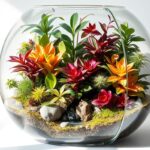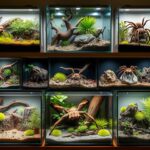How to automate temperature, humidity and light control in your terrarium

Keeping the right environment in a terrarium is key for the health of reptiles, amphibians, and plants. By automating the control of temperature, humidity, and lighting, you make it easy and consistent. This lets you create a smart terrarium that adjusts and watches over these important factors automatically.
This article will cover the perks of Terrarium Automation. We’ll talk about why Smart Terrarium Monitoring is crucial. You’ll see how to set up Environmental Control Systems for Humidity and Temperature Regulation. This ensures your terrarium is perfect for your pets.
Understanding the Need for Terrarium Automation
Keeping the right temperature, humidity, and light is key for terrarium creatures. Doing it by hand can be hard and not always right, leading to problems for the animals. Automating these controls makes it easier and keeps the environment just right, without needing to do it yourself all the time.
Maintaining Ideal Environmental Conditions
It’s vital to create the best home for your terrarium pets. Automated Misting and Lighting systems control temperature, humidity, and light perfectly. This Sensor-Driven Habitat Management removes the need for guessing and human mistakes. It makes a stable and consistent home for your terrarium’s animals.
Convenience and Consistency
Changing the terrarium’s temperature, humidity, and light by hand takes a lot of time and effort, especially if you’re busy or have many terrariums. Vivarium Automation lets you set these controls and forget them. This saves time and makes sure your terrarium pets get the steady care they need. It also boosts their health and happiness by avoiding sudden changes in their environment.

IoT Terrarium: The Future of Habitat Management
IoT technology is changing how we manage terrariums. IoT-enabled systems keep an eye on things like temperature, humidity, and light. They adjust these automatically to keep the terrarium perfect for its inhabitants.
With IoT Terrarium tech, you can watch over your terrarium from afar. Sensors track important things like temperature and humidity. Then, a control system changes settings to keep everything just right for plants or small animals.
Smart Terrarium Monitoring lets you control your terrarium from anywhere. Use apps or websites to see what’s happening, get alerts, and make changes. This is great for people who are always on the move or have many terrariums.
Bioactive Terrarium Automation takes it further. It matches automated systems with the natural needs of the terrarium. This means terrariums can be self-sustaining, thanks to smart technology. It’s the future of terrarium care, where tech and nature work together perfectly.

The future of IoT Terrarium is exciting. We’ll see more smart features like predictive maintenance and data analysis. These will change how we care for terrariums, making it more sustainable and in tune with nature.
 Use and design of temporary terrariums for transfer or quarantine
Use and design of temporary terrariums for transfer or quarantineTerrarium Automation: Essential Components
Automating a terrarium means putting together key parts that work together. These parts include temperature and humidity sensors, and automated misting and lighting systems. They are vital for keeping your plants and animals healthy and happy.
Temperature and Humidity Sensors
Keeping the right temperature and humidity is key for your terrarium’s health. These sensors check the conditions all the time. They send data to adjust the misting and lighting as needed. Studies show that up to 70% of terrariums need automated humidity control.
Automated Misting and Lighting Systems
Automated misting and lighting systems are also key for terrarium automation. They use sensor data to control water, heat, and light levels. This ensures your terrarium’s creatures get what they need to thrive. Automated systems can cut energy use by 20-30%, saving you money.
With these parts, you can make a self-sustaining terrarium. It will keep the right Humidity and Temperature Regulation and provide the right Automated Misting and Lighting. This lets your plants and animals do well with little help from you.
Setting Up an Automated Misting System
Keeping the right humidity level is key for your terrarium friends, like tarantulas. An automated misting system changes the game for your Automated Misting and Lighting and Vivarium Automation setup. When picking a misting system, think about your terrarium’s size, how much water you need, and how big the area it can cover.
Choosing the Right Misting System
The size of your terrarium is key when choosing a misting system. A big terrarium needs a strong system to keep humidity right. Make sure the system can mist the whole terrarium well, so no dry spots harm the environment.
Proper Placement and Configuration
- Put the misting nozzles in the right spots for even misting.
- Change the misting cycle’s frequency and length to fit your terrarium’s needs and the animals’ humidity likes.
- Link the misting system with your Automated Misting and Lighting and Vivarium Automation for smooth operation with other controls.
With the right automated misting system, you can make a perfect humidity spot for your Bioactive Terrarium Automation and its creatures.
Automating Lighting and Temperature Control
Automating the lighting and temperature in a terrarium is key to a smart Environmental Control Systems. Using programmable timers and controllers lets you adjust the lighting and heating for your terrarium’s needs. This way, you keep the right Humidity and Temperature Regulation for the living things in your terrarium.
Programmable Timers and Controllers
Programmable timers and controllers let you set up your Automated Misting and Lighting systems. You can program them to turn on and off lights and heating/cooling at certain times. This keeps your terrarium in the perfect environment all day and night. It’s convenient and keeps the environment consistent without needing to adjust it yourself.
You can make the lights turn on like a sunrise in the morning and off like sunset at night. Also, you can set the heating and cooling to keep a steady temperature. This keeps the perfect conditions for your terrarium.
Adding programmable timers and controllers makes your terrarium automated. This ensures the environment stays stable and right for your terrarium’s needs. This precision is key for keeping your living ecosystem healthy and thriving.
Sensor-Driven Habitat Management
Sensors are key to making terrariums automated. They watch over the environment and send real-time data. This data helps control the misting, lighting, and temperature systems. Together, they make a responsive and adaptive habitat that changes to keep the terrarium’s creatures happy.
 How to create custom terrariums tailored to the specific needs of your tarantula
How to create custom terrariums tailored to the specific needs of your tarantulaIntegrating Sensors with Automated Systems
Using sensors is crucial for Smart Terrarium Monitoring and Bioactive Terrarium Automation. These systems use sensors to check temperature, humidity, light, and more. This info goes to a control system, making changes to keep the terrarium perfect.
Automating the terrarium keeps the environment just right all the time. This is key for animals that are very sensitive. Even small changes in temperature or humidity can hurt them.
| Sensor Type | Monitoring Capability | Automated System Integration |
|---|---|---|
| Temperature Sensor | Tracks ambient temperature | Adjusts heating/cooling systems |
| Humidity Sensor | Measures moisture levels | Controls misting/venting systems |
| Light Sensor | Monitors illumination intensity | Regulates lighting schedules |
With these sensors, you can make a terrarium that’s smart and changes to meet your animals’ needs. This kind of Sensor-Driven Habitat Management is vital for the long-term health and happiness of your terrarium friends.
Terrarium Automation for Bioactive Enclosures
Automation is key for bioactive terrariums, aiming to keep a self-sustaining ecosystem. By controlling temperature, humidity, and lighting automatically, you help plants, microorganisms, and small invertebrates thrive. This balance is crucial for the well-being of all living things in the terrarium.
With Bioactive Terrarium Automation and Vivarium Automation, you can set the perfect conditions for your terrarium. This makes caring for your terrarium easier and ensures the right environment for everything to flourish.
Zebra Isopods are great for bioactive terrariums because they’re easy to care for and look nice. With automated temperature and humidity control, these isopods stay happy and active. Automated lighting that changes with the day can help plants and other creatures grow well.
| Isopod Species | Size | Temperature Range | Humidity Preference |
|---|---|---|---|
| Zebra Isopod | Larger in size | 75-80°F (21-26°C) | Moisture gradient |
| Clown Isopod | Medium-sized | 70-85°F (21-29°C) | Above 50% humidity |
Automated systems keep the balance in a bioactive terrarium, letting everything thrive. This makes caring for your terrarium easier and makes it look better. It also keeps the natural harmony of your Bioactive Terrarium Automation and Vivarium Automation setup.
Monitoring and Maintenance: Best Practices
Keeping an eye on your Smart Terrarium Monitoring and Sensor-Driven Habitat Management is key. It makes sure your Automated Reptile Habitat works well. You should check the sensors, misting systems, and lighting often to spot and fix any problems.
It’s important to regularly check your terrarium’s settings. Make sure the temperature and humidity sensors work right. Also, check the misting system to see if it’s watering correctly. And, make sure the lights turn on and off at the right times. This helps you catch any issues early and keep everything running smoothly.
Regular System Checks and Updates
Don’t forget to update your automation software and firmware. Companies often release new updates to fix bugs, improve performance, and add new features. Keeping your system updated means you get the latest improvements. This helps your terrarium’s settings work their best.
- Regularly inspect temperature and humidity sensors for proper function
- Verify the misting system is delivering the right amount of water
- Confirm the lighting schedule is accurately maintaining the desired photoperiod
- Update automation software and firmware to the latest versions
By following these best practices for Smart Terrarium Monitoring and Sensor-Driven Habitat Management, you can keep your Automated Reptile Habitat perfect for your reptiles or amphibians. This helps them stay healthy and happy.
Troubleshooting Common Automation Issues
An Automated Reptile Habitat offers many benefits but may face some problems. Issues like sensor failures, clogged misting systems, and compatibility problems can happen. Knowing how to fix these issues helps keep your Environmental Control Systems working well for Humidity and Temperature Regulation.
 A guide to introducing a new tarantula into an existing terrarium.
A guide to introducing a new tarantula into an existing terrarium.Checking sensors often is key to solving problems in your automated terrarium. If the readings are off, you might need to adjust or replace the sensors. Also, watch for anything that could block the sensor from working right.
Clogged misting systems can lead to poor humidity control. Clean the misting nozzles and tubes regularly to avoid clogs. If cleaning doesn’t fix the problem, you might need to change the misting setup or pick a better one.



